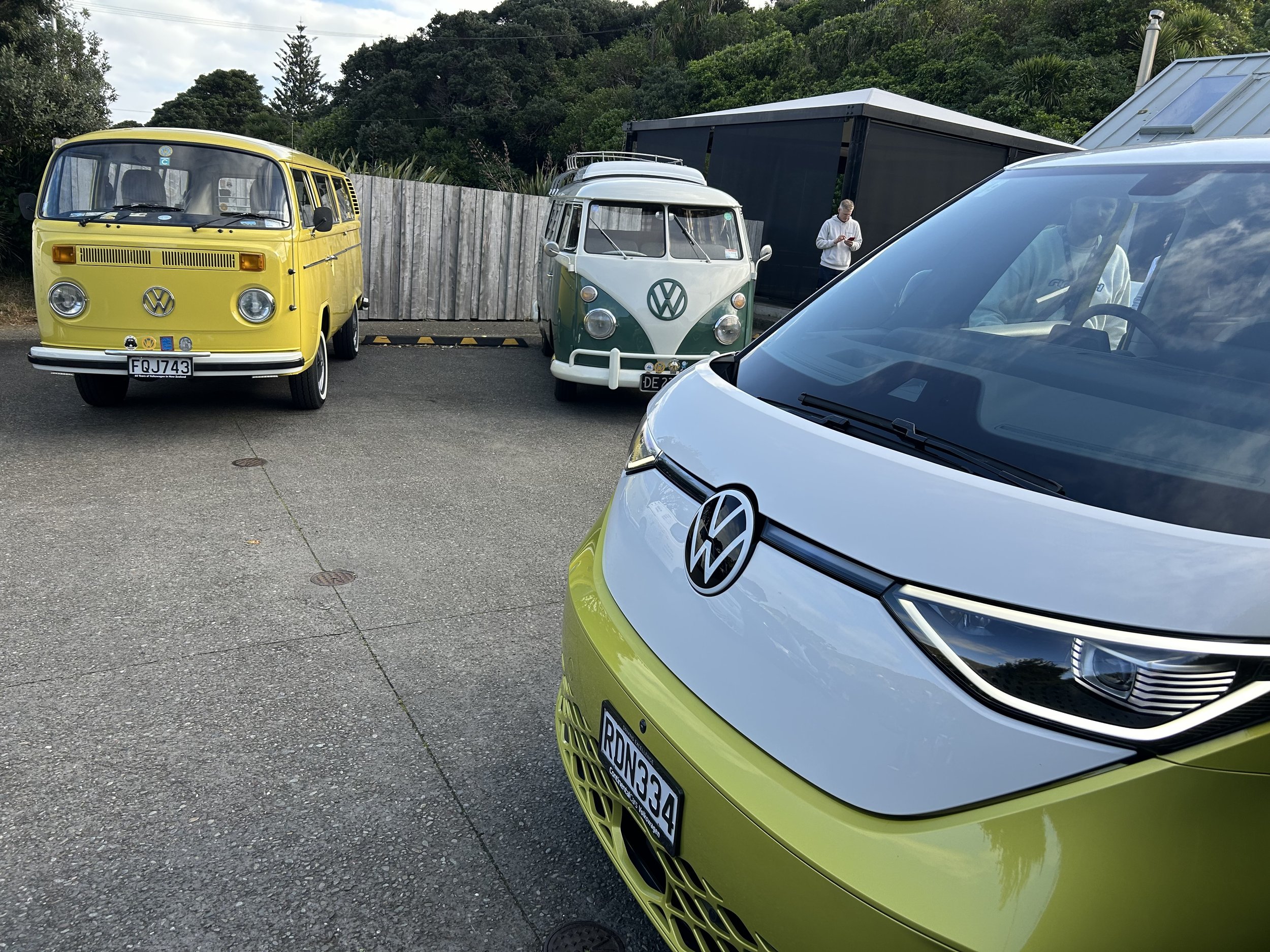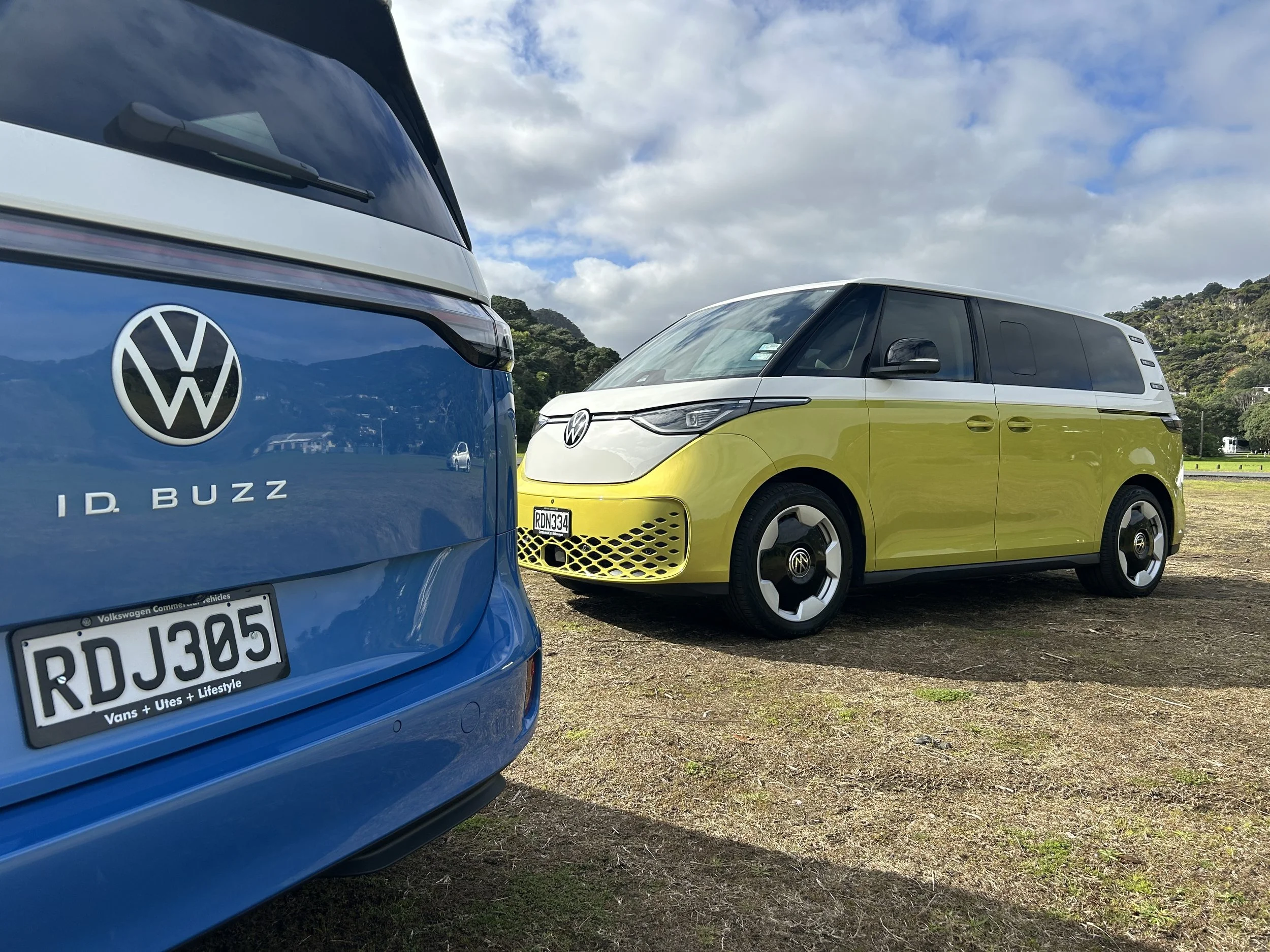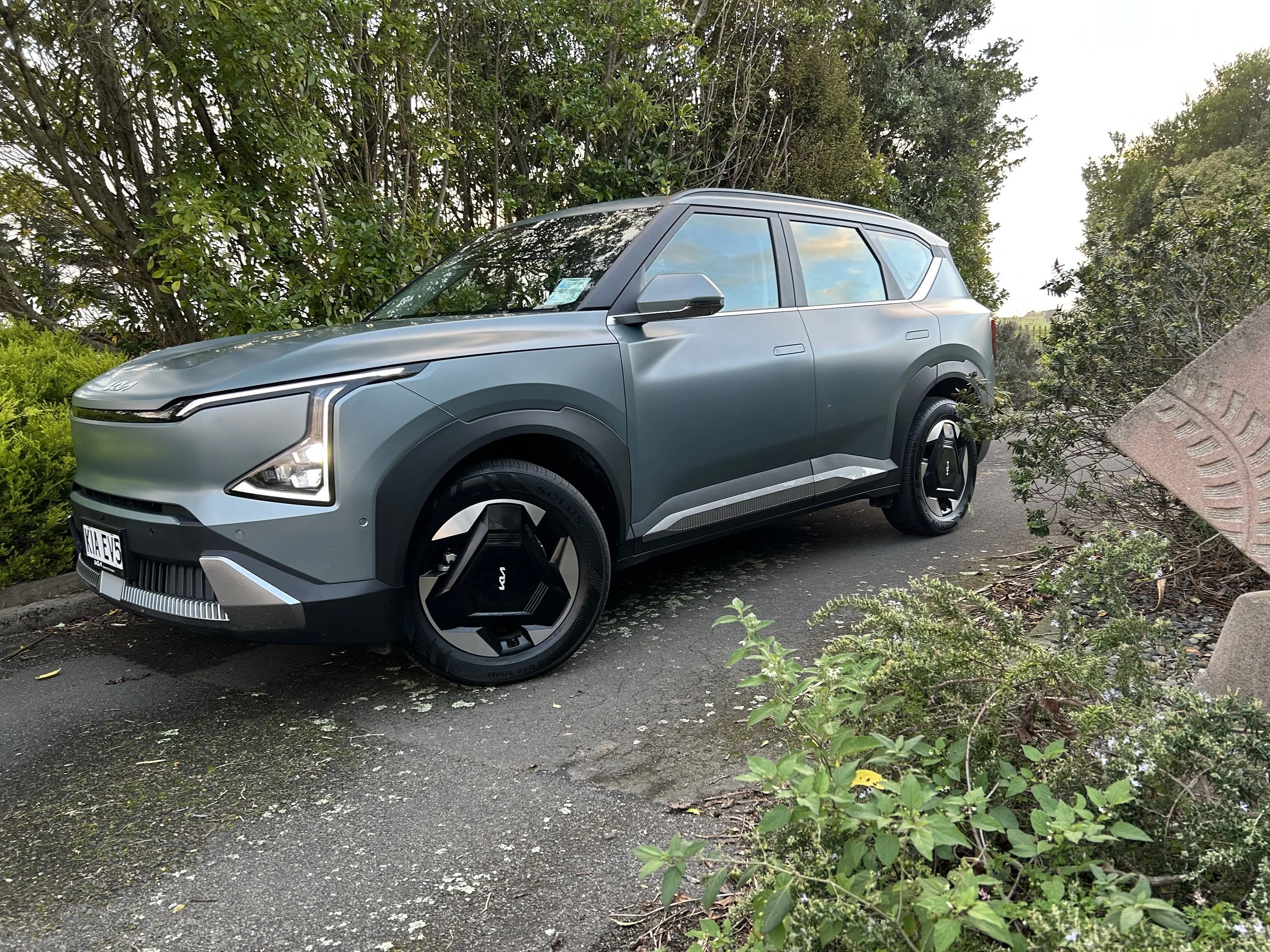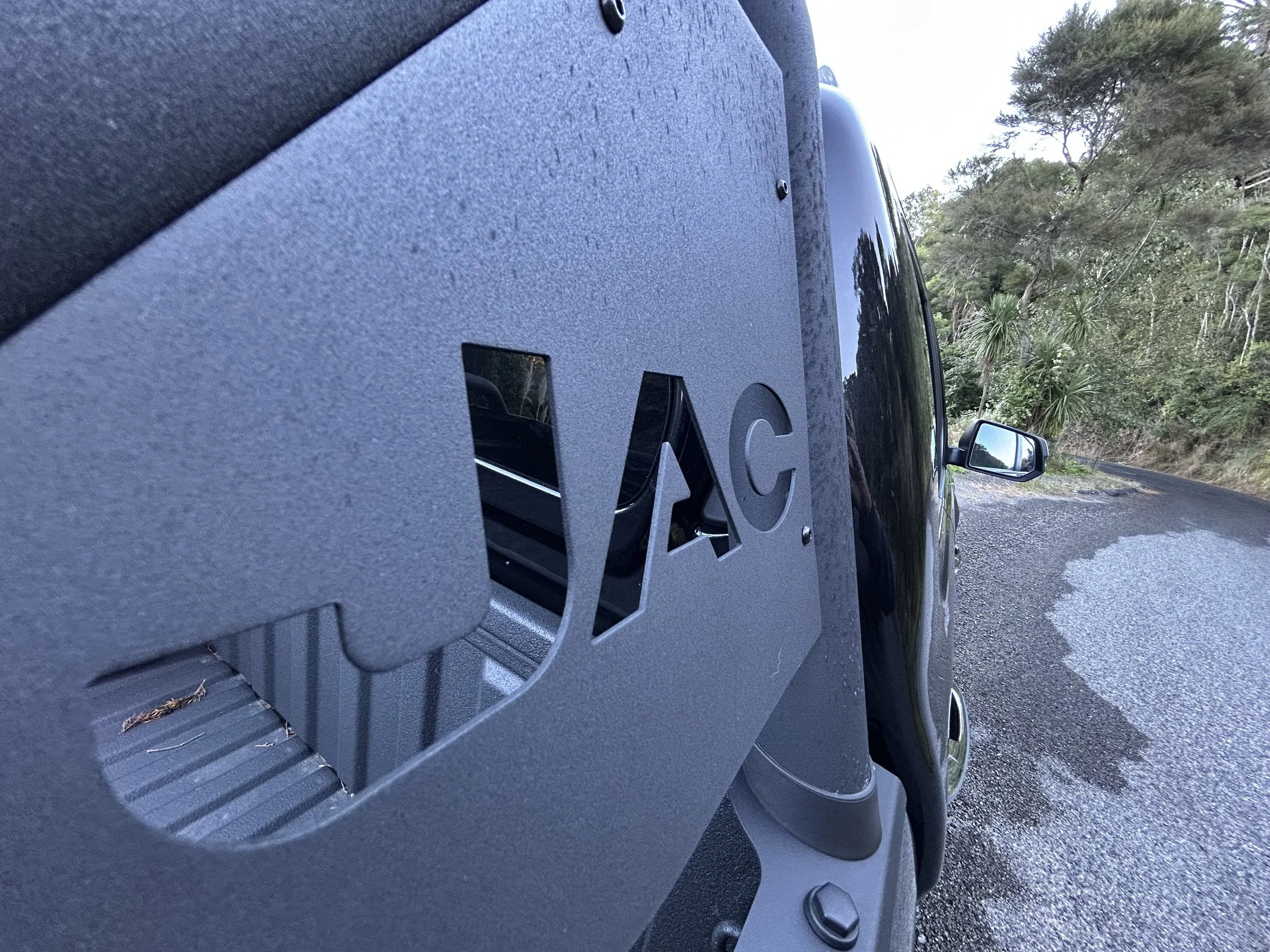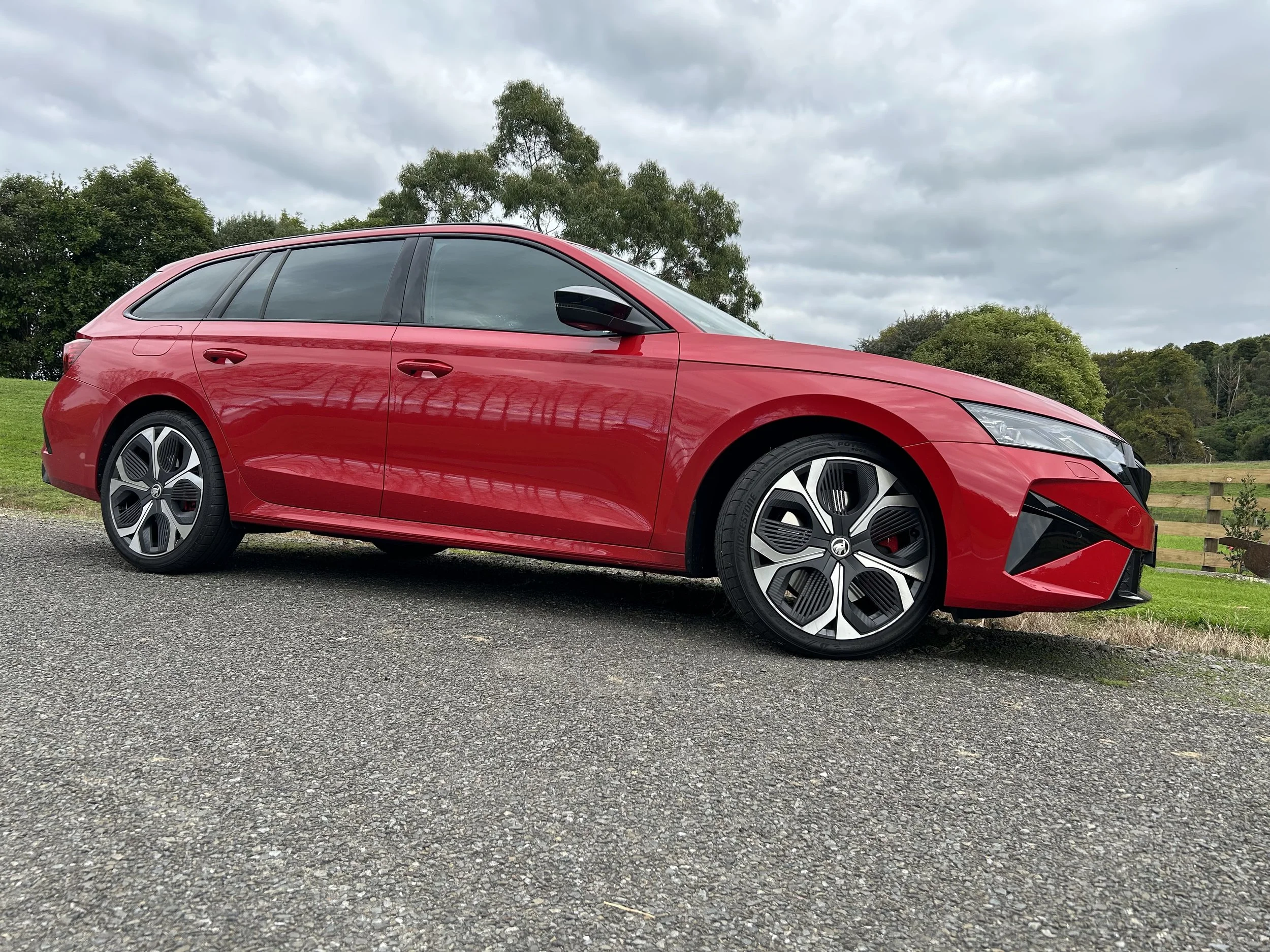VW ID.Buzz first drive: Another classic hit
/No other people carrier has turned as many heads since its international unveiling. Does the retro-cool image still carry heat three years on?
SO electric cars lack character and soul?
That’s still be true of some. But not all. The tiresome schtick certainly doesn’t stick to the Volkswagen battery bus here at last.
Blending retro hippy chic and cutting edge electric tech, ID.Buzz emphatically doesn’t lack for personality. Sure, if you’re not of a certain age, it might seem something of a Baby Boomer curiosity. Yet, going by positivity at the media day and from overseas, it seems to win all-ages approval. So cheeky. Such fun. If Pixar is ever to squeeze out yet another Cars movie, Buzz would be a shoo-in for a major role.
Shame it’s already demanding an appearance fee befitting a major movie star. The Cargo at $114,990 is a steep buy-in and the passenger-set Pro at $129,990 five seat and $139,990 in seven are big number considerations. That $149,990 GTX encroaches into Audi territory.
To be fair, VW warned right from the start its most extrovert electric would be expensive. Buzz is also high-priced everywhere.
Nonetheless, ptnetial VW is leveraging optimal profit opportunity from cashing in on the old Kombi, a model that now is considered an icon of the brand, might seem a reasonable conjecture. After all, the ID.4 on the same platform, with basically the same technical elements, is at full RRP significantly less money than the cheapest passenger-configured Buzz. Which offers the same occupant count. Still, one’s a car. The other, an automotive hallucinogenic, right?
Anyway, no need for research. It’s simple. All derivatives are more expensive than logical rivals. GTX is the second-most expensive VW, just $10k under the Touareg R.
Worth it? A first driving experience ticked off five chair Pro, the GTX and a Cargo, had all the promise of being a fun day out.
We were heading off to the seaside; they’d even given us a beach towel as a gift. A bit optimistic that, given it’s mid-winter, but we also got a chunky mug, so at least there could have been chance of a nice cup of tea after a walk along the sand. I’ve got good memories of taking just such day trips as a teen, when my mate Mark had an old T2 we all used to pile into. Just for short trips, because the clattery old bus used to be prone to exhale more express nasties into the cabin that out the back. No chance of that with a no-CO2 product.
As it turned out, the first day to enjoy the electric Buzz was too rushed for even a chance to tread so much as a grain of Piha’s black sand into its carpet. It was a quick zip from VW headquarters to the famous surfy spot, a couple of hours in a fancy restaurant (no lentils on the menu) then back to the big city. It felt like they had us spending more time at the dining table than behind the wheel.
Having around 20 minutes driving the Buzz Pro five seater, about 40 in the GTX flagship and less than 10 in the Cargo (which I skipped a very nice-looking dessert for) didn’t quite scratch an itch that has been building up over the three years between first local announcement of this model and actual on-sale appearance.
As much as it is a huge pity we have had to endure more time in the queue than was ever anticipated by the distributor or even the factory, Buzz does look to be better for turning up late.
If it turned up in 2022, this model would have served just with a single motor, 79kWh battery, as purely a Cargo commercial van and a family five-seater.
In 2025, that format remains, but two have become four. Last year Volkswagen stretched the platform to create a three-row, six/seven chair setting and bunged in a larger battery as an option. We get that as well. Optimally as that dual motor GTX, a variant which wasn’t even on the radar when VW Commercials NZ first pitched.
With the longer wheelbase, a bigger choice of finishing touches also becomes available, the most flamboyant being the largest panoramic sun roof for a VW, measuring 1.5 square metres. With photochromic tech so it can be set to clear or opaque at touch of a button.
Batteries also now charge at a maximum 200kW DC, from 170kW before. The 11kW AC charging rate means the biggest battery can replenish in seven hours and 30 minutes.
Plus there have been a host of running improvements. Rear passenger side windows used to be bonded; now they open (with the same confusing window switch as ID.4 hatch). The front seats now include adjustable armrests on the inner sides and in top-spec feature 12-way electrically adjustable seats with massage and memory functions. Design tweaks comes to a small shelf area on the dashboard in front of the passenger and a larger central storage unit that contains cupholders. Two additional cupholders can be folded out from the centre of the dashboard at a lower level. When these aren’t in use, there’s plenty of free space, big enough for small bags, as of course there is no traditional transmission tunnel, and the drive selector is on the steering column.
Also of relevance is introduction of a larger (12.9-inch) touchscreen display that is supported by improvements to the native infotainment system. Besides functional improvements including the illumination of the touch bar along the base of the screen for cabin temperature and volume controls, there is a better home screen layout that includes keeping frequently used functions visible at all times.
The driver’s 5.3-inch instrument display improves and the thin LED strip along the base of the windscreen has become more than just a styling garnish. When replenishing, the battery’s charge level is indicated visually by how far along the strip is illuminated. When using the navigation, the next turn is shown by a sweeping motion along the light bar, either to the left or right.
None of this dilutes in any way the reliance on a healthy dollop of nostalgia about what once ran by various names - Bus, Bulli, Transporter and Microbus. The yesteryear vibe is front and centre as an over-sized VW logo.
VW has been teasing retro-themed MPVs forever. There were three concepts - Microbus in 2001, Bulli of 2011 and Budd-e in 2016 - before the ID. Buzz design study of 2017 that in itself was teased in four different design concepts across two decades, from 2001, before the big global unveiling in 2022. So they’ve had plenty of time to get it just right. As child of the 1960s’, perhaps the only one at the launch event, I feel it really is.
Insignias and silhouettes imprint all over the place. The one effect most strikingly evident in the old days that is jarringly absent in the new is the soundtrack. No more clattery wheezer in the back. At least with silent running, your old Lynyrd Skynyrd favourites promise to sound all the sweeter.
The Buzz has a far more open and airy feeling than any other VW passenger product of course, yet anyone already familiar with the feel and operability of an ID car will be right at home.
It’s very well built, and though VW having to share cabin fixtures across both its commercial and passenger variants mean some plastics are perhaps a bit too obviously work boot-resistant in appearance and texture, overall the interior fit outs are very nice. The passenger areas are roomy and welcoming. The view from every seat seems expansive. The driving position is a bit bus like, but way less hunched than the original. It makes a decent practicality play; lots of USB ports in the passenger types.
Even in seven seat format, all seats in use, there's 306 litres’ boot capacity. The Cargo has a 707kg payload. Check out the clever stowage for the home recharge cable. No room for a spare wheel, though.
Standard safety fare for Buzz includes autonomous emergency braking, front and side assist, pedestrian and cyclist detection, blind spot monitoring and traffic alerts. It has a five star crash test score from Euro NCAP, awarded in 2022.
All NZ-market passenger Buzz get a powered sliding door on each side, folding mirrors, a powered tailgate. Pro models have tinted windows, keyless entry and start, stainless-steel pedal trims, alloy wheels, height adjustable front seats, heated and massage function front seats, three-zone climate-control, wireless Apple CarPlay and Android Auto, a digital radio, dynamic LED matrix headlights, rain-sensing wipers, parking sensors and voice-control. Also, there’s the ID. Buzz Box, a removable storage compartment between the front seats.
As rich as that sounds, it’s just a starting point. There are 2000 potential configurations; dare you not to start ticking options boxes.
Dressing up Buzz looks like huge fun, but you might want to have a calculator handy to keep stock of added charges.
The two tone paint schemes are $5200. Those 20 and 21 inches alloys are absolutely a better look to the 19s that are standard on everything but the 21-inch-wed GTX. But all are for $1800 and $2500. There’s a $2500 stereo and head up display upgrade for the lowest and mid-sited passenger types. GTX has a glass roof; on others it’s $4000. A luggage cover for Pro models is $900. Servicing packages are $1395 for three years, $2695 for five.
As stripped down as the Cargo is, it can also up spec to an interior Comfort package; two seats rather than three (for $550), power operation for the sliding doors and tailgate (from $1000 to $3000) and a wooden ‘universal floor’ for the back ($1700), with mounting points compatible with shelving from a German company with a local distributor.
Buyers wanting to personalise will be placing a factory order. It’s only a five month wait. Buying off the shelf is possible, too, but VW doesn’t plan to keep too many cars here, having been stung when the EV sector collapsed at end of 2023. That left it with 1200 ID.4 and ID.5 cars it was forced to fire sale. Never again.
Cargo and entry Pro’s 4712mm wheelbase is designated NWB; the first letter being for ‘normal.’ It’s a bit odd that the Pro can be built in three-by-three configuration, but as a $2400 extra, whereas it’s a no cost option for the Pro and GTX on the 4932mm wheelbase, which otherwise come with seven chairs.
Which to go for? The entry Pro risks being called a vastly over-scale hatchback, but reality is that it’s more than this. Still, the prudence of creating a long wheelbase is obvious; it not only offers more seating arrangements, but is expansive enough that the third row that can comfortably seat two adults.
In the factory’s primary setup, the middle row is a bench seat with a 60:40 split, and it can slide forward by up to 200mm to create more room for those in the rearmost seats.
Buzz Pro editions and Cargo continue the original 210kW/560Nm single motor, rear drive configuration, with WLTP test assessed ranges of between 382 and 403 kilometres. It’s surely going to be good enough for most.
The GTX is the one out to be most discussed. For decades, VW has made sportier versions of its most popular models under the GTI moniker. That it is doing the same with its electric vehicles, but under a different yet same-ish branding, is logical. But a go-fast people carrier van with large wheels, sports tyres and firm suspension is quite a big endeavour.
Despite the dynamic enhancements, a lot relies on the ‘4Motion’ all-wheel-drive system. Obviously there is no physical drive connection between the front and rear electric motors. They work in tandem when needed to provide all-wheel traction.
VW uses two types of motors in the GTX, including the latest permanent magnet synchronous motor (PSM) in the rear, known internally as the APP550. This alone produces up to 213kW and 560Nm and is supplemented by an asynchronous motor (ASM) on the front, which has maximum outputs of 81kW and 134Nm. Total combined maximum power is just 40kW above that from the single motor, torque is 90Nm meatier and it’s the latter that is more influential in GTX’s hot vibe evidencing with a zestier take-off. With a cited 6.4 seconds for 0100kmh, it has a 1.5s advantage over the others. It also has more on paper grunt than a Golf R.
For the majority of the time, GTX always remains in rear-wheel-drive mode, with motor up front in a standby setting, set to instantly enact when traction levels at the rear begin to drop.
My driving partner went all out to unwrap the perceived playfulness on the winding road out of Piha. From the passenger side, the experience was a bit unnerving. Hurling into a corner I was grateful it kept traction and grip as weight influence on the dynamics was obvious. Top speed being contained to 160kmh seemed sensible at that moment.
Another takeaway is that GTX’s ride quality is firmer than from the others. As those already evidence a bit of choppiness, that side of things could become an issue if your driving regime takes on coarse chip or worse.
It has the air of a free spirit, all the same, with a slightly different look to the regular version doing it proud. With GTX the lower section of the front bumper is bespoke, featuring a large honeycomb structure with a gloss black finish and a winglet appearance on either side. Small vertical LED daytime running lights are integrated into the sides of the bumper, taking the shape of two triangles on top of each other to form an arrowhead design. The door mirror housings and badges also receive a high-gloss black finish.
GTX also getting darker colours throughout the interior, with red stitching highlights, attunes it to VW’s usual performance car themes, but in this setting it might risk seeming too sombre. The Pro models, with their brighter hues - including a snappy blue - are simply cheerier.
The big win for Buzz is that it achieves stated aim of getting under your skin. Though it potentially helps if you actually do have memory of the ‘60s and ‘70s, you need no cultural affinity for the original to enjoy it. Just as well because in all likelihood those who grew up in the era of free Wi-Fi, not free love, are going to be the core audience. But they seem to … erm … ‘dig it’ too.
It truly seems one of those vehicles you’ll look back at with genuine affection after taking it for a drive, regardless that in some ways that actual on-road experience is a bit anodyne in some aspects.
What next for Buzz? Well, as every diehard knows, the electric theme curiously has yet to come to the most classic Kombi of all, the camper.
Sure, VW very much fulfils already with its California models, and because of that has messaged reluctance to put Buzz in that space as well.
But still … a Buzz that’s akin to the clapped out of Kombis Kiwis took on their big OE adventures around Europe back in the day? That’d have to be a cool ride you can imagine some owners might strive to emulate, regardless on what the factory decides.
Meantime, it’s here … here at last. And that’s great. That VW had the balls to make it. Bravo again.
It knows full well that, as much as revived retro can be a big thing, it’s not without risk. Being electric allows it to tick the future-forward box.
On the other hand, Aside from having to off-load ID.4/ID.5 at prices cheaper than anywhere else in the world, it had the experience of New Beetle being hot, hot, hot … and then not. No wonder Buzz volume is being carefully overseen and onus is on each buyer stumping up to have their cars built and shipped out.
Still, having such a personable vehicle created by VW to exactly suit your own personality is one heck of a story to share over a coffee at a chic cafe while you chat about those long ago trips to Nepal and Marrakesh.



